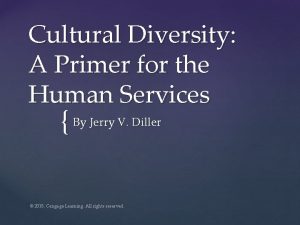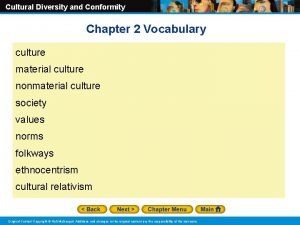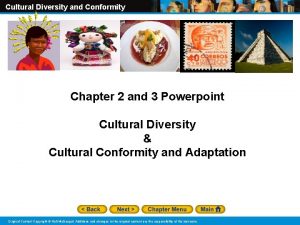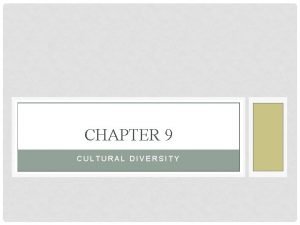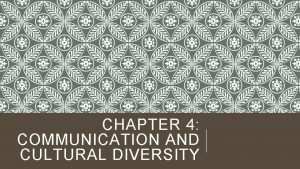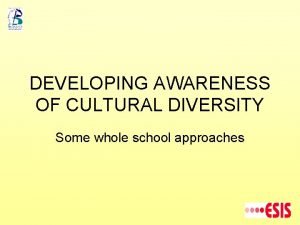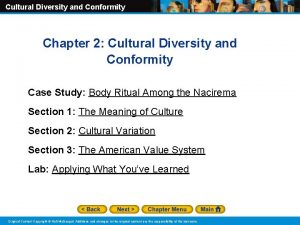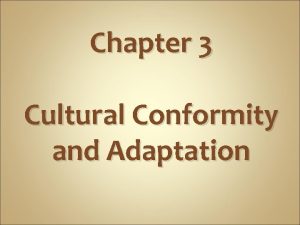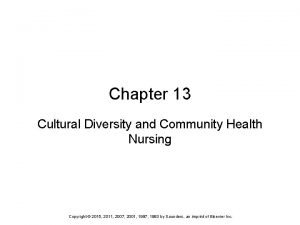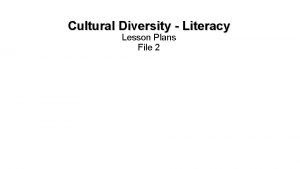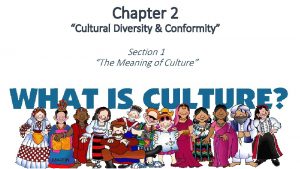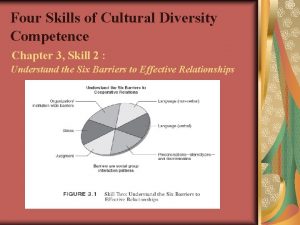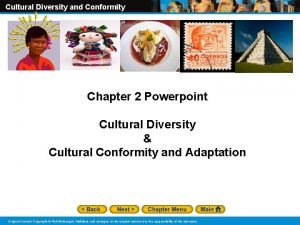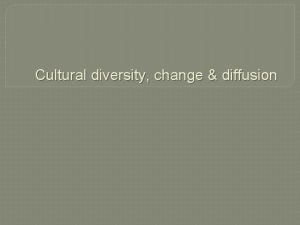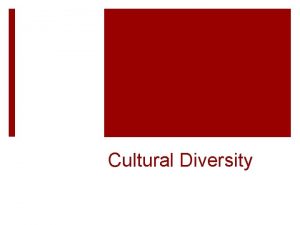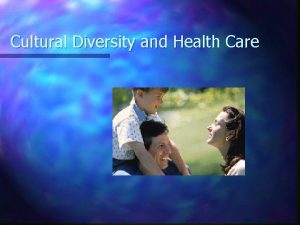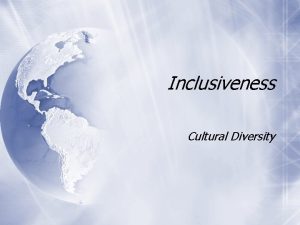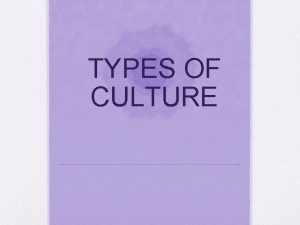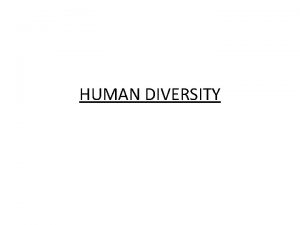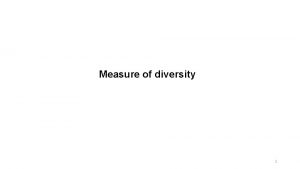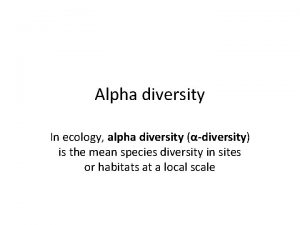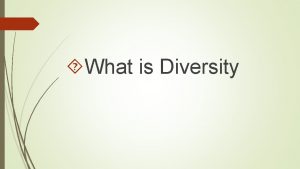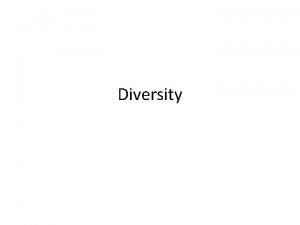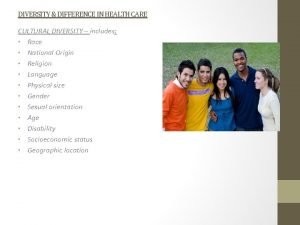Cultural Diversity A Primer for the Human Services































- Slides: 31

Cultural Diversity: A Primer for the Human Services { By Jerry V. Diller © 2015. Cengage Learning. All rights reserved.

Chapter 6 { © 2015. Cengage Learning. All rights reserved. Working With Culturally Diverse Parents and Families

Open Letter To Barack Obama Alice Walker characterizes the traits of Barack Obama and the values within the Black community that created the path to his victory: Self-empowerment and pride Resiliency and self-care Retaining a sense of spirit and hope An awareness of the various societal practices and institutions that have created obstacles for communities of color © 2015. Cengage Learning. All rights reserved.

Community Psychology An approach focused on making interventions at all systemic levels, including individual, social networks, support systems, communities, and within society as a whole © 2015. Cengage Learning. All rights reserved.

Community Psychology Involves: A focus on correcting social injustice Promoting well-being Eliminating oppression Prevention and promotion of mental health Acknowledging power differentials in society Community development and empowerment Social commitment and accountability for professionals © 2015. Cengage Learning. All rights reserved.

Case Study 1: Just Therapy Spirituality, Justice, and Simplicity Therapy as a sacred process Justice as recognizing the structures that create oppression and highlighting equity Simplicity should be reflected in therapeutic exchanges What is “Just Therapy? ” A modality that accounts for the gender, cultural, social and economic context of the client; broad contextual approach © 2015. Cengage Learning. All rights reserved.

Two Scenarios Scenario 1: A Cherokee mother and Hopi father have different approaches to the problems of their son, who is acting out The issue corresponded to different ideas between the two cultures on the role of a father in parenting The issue was eventually resolved through consultation with an elder © 2015. Cengage Learning. All rights reserved.

Two Scenarios Scenario 2: A Chinese American husband Irish American wife disagreed over the role, intentions, and affects of the mother-in-law in their relationship When the cultural dimension was added to the personal dimension of the problem, the couple was able to see how the problem could be amended © 2015. Cengage Learning. All rights reserved.

Creating a Buffer Zone Parents of color must create a safe environment in which their children can grow up safely despite racism © 2015. Cengage Learning. All rights reserved.

Creating a Buffer Zone Parents create an environment in which the child is protected from negative attitudes and stereotypes The family is the primary sculptor of self esteem; consistent loving and nurturing interaction lead to good sense of self Creates a time and place for optimal personal growth, which leads to higher social functioning, cognitive development, and emotional health and stability © 2015. Cengage Learning. All rights reserved.

Parenting for Self-Esteem Three crucial ways in which parents (especially African American) develop or negate self-worth Disciplinary style Physical punishment may erode self-esteem, while gentler discipline fosters greater emotional health Parental closeness or distance Parent physical and emotional involvement leads to development of positive self-worth; conversely, children may blame themselves for parental absence © 2015. Cengage Learning. All rights reserved.

Parenting for Self-Esteem Three crucial ways in which parents (especially African American) develop or negate self-worth Attitude toward race Premature sensitization to race before developmental readiness, and habitually blaming racism can diminish children’s future coping abilities (controversial) © 2015. Cengage Learning. All rights reserved.

Preparing Children Emotionally for Racism Children need to feel the support of family, peers, and teachers Children need to understand the history of individuals who have struggled against racism © 2015. Cengage Learning. All rights reserved.

Preparing Children Emotionally for Racism Counterproductive strategies include: Verbal regiments (e. g. , “Black is Beautiful”) are used to reinforce a message of positive selfesteem, but can make children question their validity Overly permissive stances due to guilt, or to make up for harshness the child will encounter, do not allow children to test themselves and build self-esteem © 2015. Cengage Learning. All rights reserved.

Preparing Children Emotionally for Racism Counterproductive strategies include: Overly authoritative parenting intended to toughen children for the harsh reality they face can lead to abuse or to the child becoming abusive Encouraging children to avoid aggressive behavior or to remain passive in the face of racism, as if such a stance would soften racial hatred Instead, children should learn to manage righteous anger © 2015. Cengage Learning. All rights reserved.

Preparing Children Cognitively for Racism Lewin (1948) offers advice: Never deny a child his/her ethnicity or diminish it’s importance By putting off the discussion of racism, parents remove themselves as a valuable resource and make experiences with racism more devastating Help children develop positive ethnic identities based on values of the group © 2015. Cengage Learning. All rights reserved.

Preparing Children Cognitively for Racism Lewin (1948) offers advice: Racial hatred should be presented as a social problem and not an individual problem, as children tend to take responsibility for most things that happen to them © 2015. Cengage Learning. All rights reserved.

Preparing Children Cognitively for Racism Lewin (1948) offers advice: Teach children that group membership is based on physical/cultural features and shared history in order to heighten intragroup solidarity and prevent intragroup fighting Ensure children do not fear multiple group allegiances or feel they have to choose between alternative roles and group membership Model positive feeling about ethnicity and group membership © 2015. Cengage Learning. All rights reserved.

Bicultural Children And Families Three prevalent myths about bicultural children (Kerwin & Ponterotto, 1995) Bicultural children turn out to be tragic and marginal individuals In fact, they usually develop healthy and stable identities Bicultural children must choose to identify with only one of their parents’ cultural groups In fact, healthy development includes an integration of both cultural backgrounds © 2015. Cengage Learning. All rights reserved.

Bicultural Children And Families Three prevalent myths about bicultural children (Kerwin & Ponterotto, 1995) Bicultural children are very uncomfortable discussing their ethnic identity with others In fact, children welcome the opportunity for discussion and exploration © 2015. Cengage Learning. All rights reserved.

Bicultural Couples Characteristics of bicultural couples Couples may approximate extremes Some are high-functioning and have advanced communication skills, others have poor interpersonal skills and little insight Communities of color are often more accepting of bicultural relationships than Whites With the exception of Asian communities © 2015. Cengage Learning. All rights reserved.

Bicultural Couples Characteristics of bicultural couples Bicultural couples report frequent focus on race and ethnicity within their relationship based on the existence of a microcosm of race relations within the home Couples tend to be isolated as a unit, developing strong patterns of interdependence Couples navigate personality differences and conflicts, but also the complex difficulties of cultural differences © 2015. Cengage Learning. All rights reserved.

Three Patterns of Cultural Tension (Falicov, 1986) Conflicts in cultural code Differences in how marriage is perceived, including authority roles and the place of extended family © 2015. Cengage Learning. All rights reserved.

Three Patterns of Cultural Tension (Falicov, 1986) Permission to marry Parental disapproval of the relationship and subsequent patterns of adaptation in couples who have not received emotional permission to marry Partners either maximize or minimize their differences, either leading parallel lives or creating their own third culture Children are either asked to choose a cultural identity or are isolated from culture © 2015. Cengage Learning. All rights reserved.

Three Patterns of Cultural Tension (Falicov, 1986) Cultural stereotyping Stress leads to maximization of cultural differences and stereotyping between partners, where cultural material that was previously addressed is used as a defense against addressing other non-cultural issues Children in these families need help negotiating the pull of the two competing cultures © 2015. Cengage Learning. All rights reserved.

Bicultural Children Bicultural children represent their parents’ racial differences but are also unique individuals with unique racial conflicts Bicultural children: Develop awareness at a younger age than monocultural children of color (by age 3 -4), and are more successful in developing racial identity when it is openly discussed in the home © 2015. Cengage Learning. All rights reserved.

Bicultural Children Bicultural children: Have unique issues in adolescence, when identification becomes more aligned with peers of color This can cause strain in relationships with parents, especially when one is White Can experience special difficulties in divorce and single parent situations, where anger is often demonstrated as racism © 2015. Cengage Learning. All rights reserved.

Adopted Children Adoption is a second source of biracial children Issues include: Communities of color strongly disagree with adoption across racial lines and believe that Whites are not capable of dealing with racism © 2015. Cengage Learning. All rights reserved.

Adopted Children Issues include: White adoptive parents often do not understand the reality faced by people of color Confusing for adopted children of color to reconcile perceptions of their adopted parents that represent both nurturance and oppression © 2015. Cengage Learning. All rights reserved.

Therapy With Bicultural Families Therapy with bicultural families should employ strategies that help develop positive feelings about membership in both parents’ groups © 2015. Cengage Learning. All rights reserved.

Therapy With Bicultural Families Interventions include: Confronting devaluing or mixed racial messages Noticing the existence of devaluing messages and addressing them in therapy Freeing children from racialized loyalty binds Giving children permission to have their own relationship with each parent Fostering strategies for resisting racism Teaching families to have conversations about race, with special sensitivity from White parents © 2015. Cengage Learning. All rights reserved.
 Cultural diversity a primer for the human services
Cultural diversity a primer for the human services Genetic diversity vs species diversity
Genetic diversity vs species diversity Ecosystem jigsaw activity
Ecosystem jigsaw activity Wake county human services community services center
Wake county human services community services center Melting pot
Melting pot Tcole cultural diversity 3939
Tcole cultural diversity 3939 Cultural diversity and conformity section 2 answers
Cultural diversity and conformity section 2 answers Cultural diversity and conformity section 1
Cultural diversity and conformity section 1 Chapter 9 cultural diversity
Chapter 9 cultural diversity Chapter 4 communication and cultural diversity
Chapter 4 communication and cultural diversity Cultural diversity examples
Cultural diversity examples 2009 delmar cengage learning
2009 delmar cengage learning East africa has great cultural diversity because of its -
East africa has great cultural diversity because of its - Cultural diversity in phlebotomy
Cultural diversity in phlebotomy Socio-cultural diversity
Socio-cultural diversity Whole school approach to cultural diversity
Whole school approach to cultural diversity Cultural diversity and conformity
Cultural diversity and conformity Cultural diversity and conformity chapter test form a
Cultural diversity and conformity chapter test form a Cultural diversity and conformity section 1
Cultural diversity and conformity section 1 Culturological assessment
Culturological assessment Cultural diversity means a range of different
Cultural diversity means a range of different Cultural diversity pros and cons
Cultural diversity pros and cons Cultural diversity 3939 answers
Cultural diversity 3939 answers Cultural diversity and conformity section 1
Cultural diversity and conformity section 1 Cultural diversity 3939 answers
Cultural diversity 3939 answers Positive and negative effects of cultural diversity
Positive and negative effects of cultural diversity Four skills of cultural diversity competence
Four skills of cultural diversity competence Cultural diversity hands
Cultural diversity hands Cultural diversity and conformity section 1
Cultural diversity and conformity section 1 Nature nurture and human diversity
Nature nurture and human diversity Chapter 8 study guide human resources culture and diversity
Chapter 8 study guide human resources culture and diversity Chapter 8 study guide human resources culture and diversity
Chapter 8 study guide human resources culture and diversity
